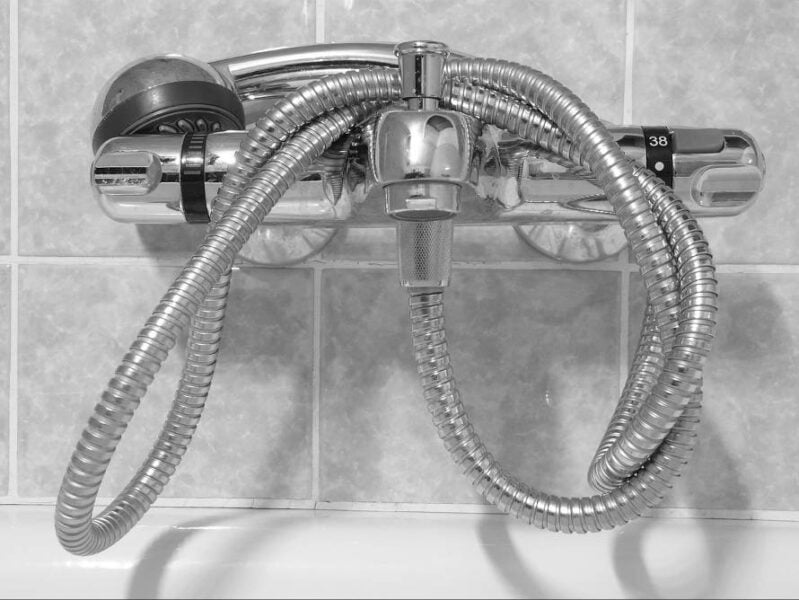Northwestern University researchers have discovered a remarkably diverse collection of viruses living on showerheads and toothbrushes, revealing an unexpected hotspot of microbial life in our homes.
Summary: A new study identified over 600 different viruses, mostly previously unknown, on toothbrushes and showerheads. These bacteriophages, which target bacteria rather than humans, could potentially be used to combat antibiotic-resistant infections.
Estimated reading time: 6 minutes
In a groundbreaking study published in Frontiers in Microbiomes, microbiologists from Northwestern University have uncovered a surprising wealth of viral biodiversity lurking in our bathrooms. The research team, led by Associate Professor Erica M. Hartmann, found that showerheads and toothbrushes harbor an incredibly diverse array of viruses, most of which were previously unknown to science.
Uncovering the Hidden World of Bathroom Microbes
The study examined samples collected from showerheads and toothbrushes, identifying more than 600 different viruses. Surprisingly, no two samples shared the same viral profile, highlighting the extreme diversity of these microbial communities.
Hartmann, an indoor microbiologist at Northwestern’s McCormick School of Engineering, expressed her astonishment at the findings:
“The number of viruses that we found is absolutely wild. We found many viruses that we know very little about and many others that we have never seen before. It’s amazing how much untapped biodiversity is all around us. And you don’t even have to go far to find it; it’s right under our noses.”
Bacteriophages: The Beneficial Viruses
While the idea of viruses in our bathrooms might sound alarming, these particular microorganisms are not harmful to humans. Instead, they are bacteriophages, or “phages” – viruses that specifically infect and replicate within bacteria.
The discovery of such a diverse collection of phages is particularly exciting due to their potential applications in medicine. Researchers are increasingly interested in using phages to treat antibiotic-resistant bacterial infections, making this newfound bacterial diversity a potential treasure trove for future medical research.
Distinct Microbial Ecosystems
One of the most surprising aspects of the study was the lack of overlap between viral communities found on different surfaces. Hartmann noted:
“We saw basically no overlap in virus types between showerheads and toothbrushes. We also saw very little overlap between any two samples at all. Each showerhead and each toothbrush is like its own little island. It just underscores the incredible diversity of viruses out there.”
This finding suggests that even within the confined space of a bathroom, distinct microbial ecosystems can develop on different surfaces.
Potential Applications and Future Research
While the study primarily focused on identifying and cataloging these viruses, the researchers are already considering potential applications for their findings. For instance, they observed a higher prevalence of mycobacteriophages, which infect bacteria responsible for diseases like tuberculosis and leprosy.
Hartmann speculated on possible future uses:
“We could envision taking these mycobacteriophage and using them as a way to clean pathogens out of your plumbing system. We want to look at all the functions these viruses might have and figure out how we can use them.”
No Need for Panic: Embracing Our Microbial Cohabitants
Despite the surprising abundance of microbes found in bathrooms, Hartmann cautions against overreacting or reaching for harsh disinfectants. She advocates for a more balanced approach to household cleaning:
“Microbes are everywhere, and the vast majority of them will not make us sick. The more you attack them with disinfectants, the more they are likely to develop resistance or become more difficult to treat. We should all just embrace them.”
Instead of aggressive cleaning methods, Hartmann recommends simple maintenance like soaking showerheads in vinegar to remove calcium buildup or washing them with plain soap and water. For toothbrushes, regular replacement of brush heads is sufficient.
This study not only sheds light on the hidden biodiversity in our homes but also opens up new avenues for research into potential medical applications of these newly discovered viruses. As we continue to explore the microscopic world around us, we may find that the key to solving some of our most pressing health challenges is closer than we ever imagined – perhaps as close as our own bathrooms.
Quiz: Test Your Understanding
- How many different viruses did the study identify in bathroom samples? a) Over 100 b) Over 300 c) Over 600 d) Over 1000
- What type of viruses were primarily found in the study? a) Influenza viruses b) Coronaviruses c) Bacteriophages d) Retroviruses
- According to the researcher, what is a potential future application of the discovered viruses? a) Creating new cleaning products b) Developing new vaccines c) Cleaning pathogens out of plumbing systems d) Enhancing water purification
Answers:
- c) Over 600
- c) Bacteriophages
- c) Cleaning pathogens out of plumbing systems
Further Reading
- Frontiers in Microbiomes – Full Study
- Northwestern University – Center for Synthetic Biology
- World Health Organization – Antimicrobial Resistance Information
Glossary of Terms
- Bacteriophage (Phage): A virus that infects and replicates within bacteria
- Microbiome: The community of microorganisms in a particular environment
- Antibiotic resistance: The ability of bacteria to withstand the effects of antibiotics
- Mycobacteriophage: A bacteriophage that specifically infects mycobacteria
- Biodiversity: The variety of life in a particular habitat or ecosystem
- Indoor microbiologist: A scientist who studies microorganisms found in indoor environments
Enjoy this story? Get our newsletter! https://scienceblog.substack.com/


